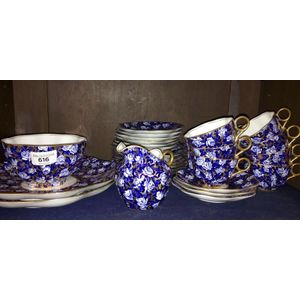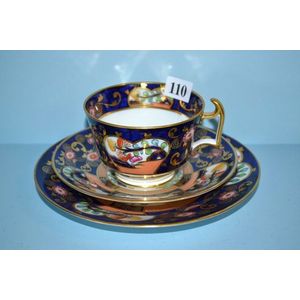
Spode Tea Set: Elegant English 19th Century Pairing
A collection of Spode tea-wares, a setting for two English, 19th century

Spode Blue and White Covered Sucrier, 1815
A Spode blue and white porcelain covered sucrier, circa 1815, of tapering rectangular form with a boat shaped rim and conforming cover with finial, with small applied handles and printed overall in the 'Two Temples' pattern; with printed marks to cover…

Copeland Neo Classical Plaque with Venus and Cupid
A Copeland Pottery Neo Classical Plaque. Signed P Ipson Danish 19th century depicting Venus with Cupid. 23 x 21 cm

Copeland Spode Whisky Bottles with Stoppers
Pair of Copeland Spode whisky bottles with original stoppers

Spode Canisters and English Tureen Set
Four Spode blue room canisters along with an English tureen (5)

Spode Italian Platters, Blue & White, 1920s, Chip
Two Spode Italian blue & white platters circa 1920s, one with chip to rim, 32 cm & 37 cm wide

Spode Imari Sucrier, 1815
A Spode two handled lidded sucrier, circa 1815, of compressed rectangular form with a convex shaped rim and conforming lid, decorated in the china style Imari pattern 1495 with walled gardens hiding lush foliage behind and roundels of birds and gilt…

Spode Indian Sporting Sauce Tureen with 'Hunting a Hog Deer'
A Spode 'Indian Sporting' pattern sauce tureen and cover, circa 1820, of oval bombe shape with square loop handles to the ends and cover, transfer-printed in blue with 'Hunting a Hog Deer' from the series, printed marks underside both pieces. Height 12.5…

Spode Floral Cups and Saucers, C.1820
Three early 19th century Spode porcelain cups and saucers finely painted with floral sprays on a low relief pattern. Marked Spode 2527. Gilt borders. C.1820. Width 13.5 cm

Spode Herb and Spice Containers Set of 6
Set of 6 Spode 'The Blue Room Collection' herb and spice containers

Antique Dresser-designed Spode Watering Can
Antique Copeland Spode watering can, designed by Dr Christopher Dresser circa 1890, 23.5 cm high







 Loading more...
Loading more...